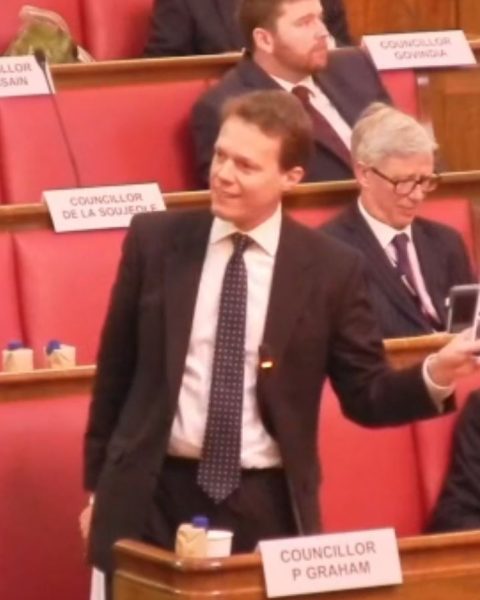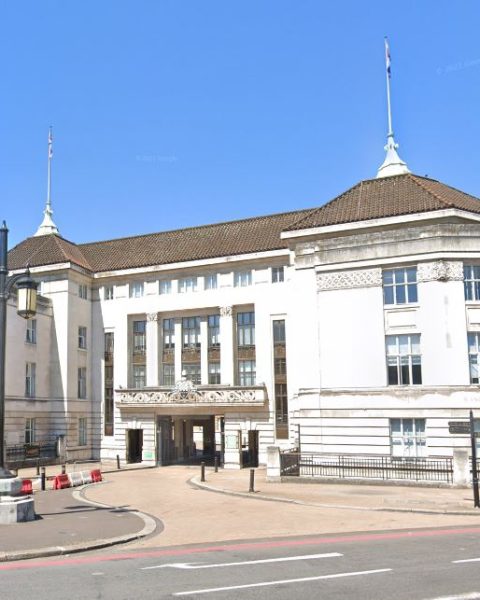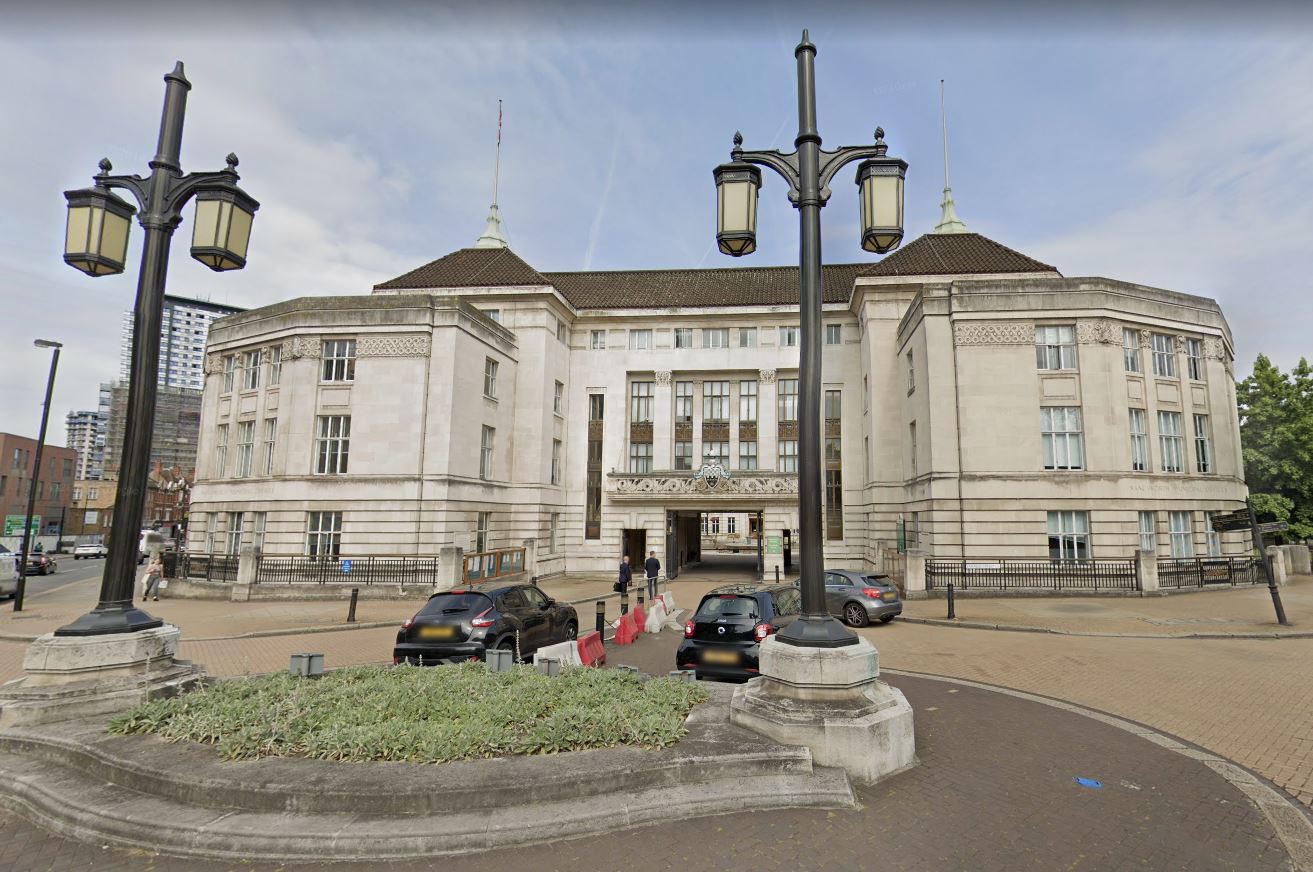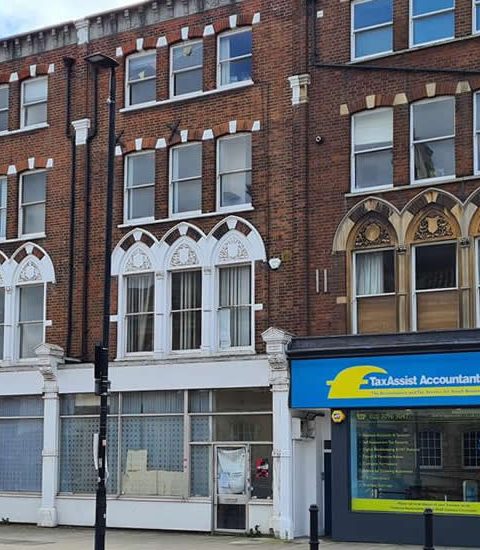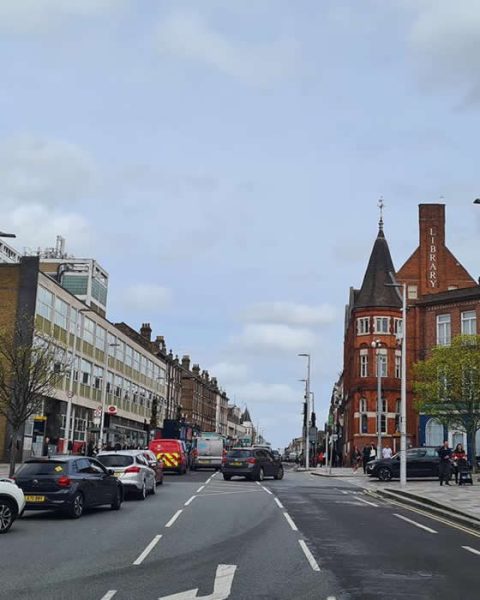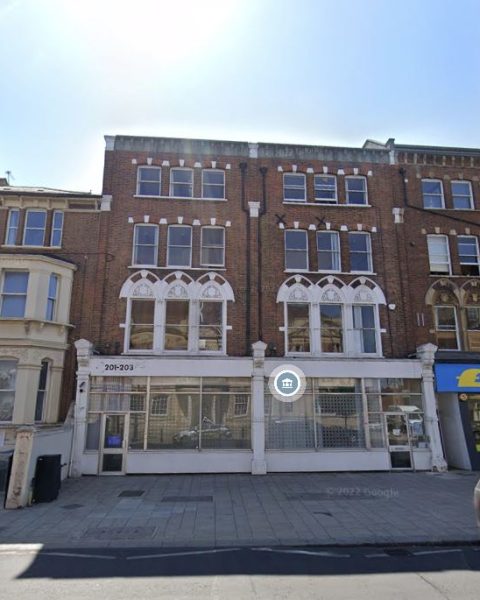Author: Cyril Richert
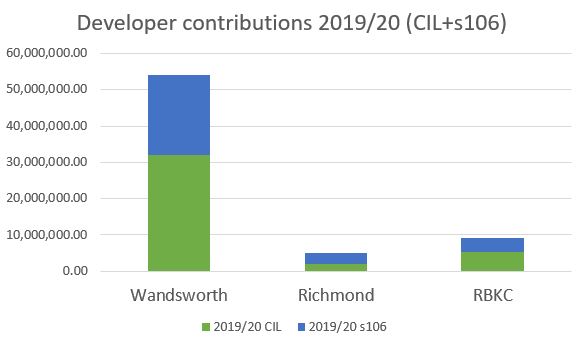
You won’t be surprised to learn that Wandsworth generates a lot of income from developers, but the scale of the figures is astonishing in comparison to some of our neighbours.
For example, since implementation, Richmond received a cumulative income of £11,6m and £19m for Kensington and Chelsea (RBKC), while Wandsworth got … £150m for the same period. Nearly 8 times more!
The Community Infrastructure Levy (CIL) is a standard charge based on new development size and location. It came into force in England and Wales in April 2010 and Wandsworth was one of the first London borough to implement it as soon as 2012. The money can be used by the Council to fund nearly everything that can be related to infrastructure, which means most of the things that you will see in the borough, from CCTV implementation to school improvement, road work, park maintenance, etc.

We have compiled all annual CIL reports available (from 2012 to 2020) along with comparison using the latest Infrastructure Funding Statement (IFS) report that they are now required to publish (sometime figures slightly differ but are similar). As we said in introduction, the cumulative amount (£150m) that Wandsworth Council has collected is amazing in comparison to its neighbours. You might interject that this is due to Nine Elms and the forest of skyscrapers emerging in that zone, but as we demonstrate in this article, it is only a share, not the main contribution.
What is given in Nine Elms stays in Nine Elms
Nine Elms is indeed a specific area. Not only the Council decided that the rules for the level of affordable development requires in new developments does not apply (see our article), but it also consider that all of the CIL raised in that area must be ring-fenced to fund and support that specific location (which represent a tenth of the borough) and therefore is not available for the rest of the borough. Therefore, not only developers have less obligations in Nine Elms, notably in term of affordable housing provision, but this cannot be compensated with the rest of the borough through their contribution. What is given in Nine Elms stays in Nine Elms!

We have compared above the Strategic CIL (which represents more than 85% of the CIL). We will consider later the neighbourhood CIL (~15%, as Wandsworth as here again managed to lower its obligations, see at the bottom of this article). Although Nine Elms represents a large part of the CIL generated, it is not at all the majority. Other area such as Putney, Battersea river side or York Road area are good examples of massive developments that are contributing to the pot.

The cumulative strategic CIL generated by Nine Elms (VNEB opportunity area) is £57m and the rest of the borough has generated a total of £74m since 2012.
Massive underspend in the local fund
The neighbourhood CIL represents a small percentage that local authorities must – by law – spend in the area where it has been generated. The idea is to show that developments are generating direct benefits to the local community (this is similar to s106 contribution, another payment made by developers to offset the harm caused by their schemes). It is therefore interesting to compare how much money was actually received for the local areas, and compare to the actual spending in each zone.

The level of underspending is particularly noticeable at a local level because it should be used rapidly to local benefits, while you could expect strategic CIL mostly focusing on bigger projects.

Under spending is not a characteristic of Wandsworth. In March 2021, Property Week wrote:
The comparison shows overall a ratio of 40% spending for the total CIL received. However, this figures is grossly biased by a massive spending last year to refurbish several schools and places in the borough, including Putney Ark Academy (Elliott school) which received a massive payment of £13m (to put in perspective, imagine that nearly all Richmond’s CIL money collected over the years was going to a single project).

If we remove the last financial year, the total spending is 19% of the income, which is in line with the finding from Property Week in 2019 which said:
“Our numbers show that local authorities received CIL payments totalling £967m, of which just £191m – or 20% – was spent. “
You will also notice that the cash collected by Wandsworth for granting development represents about 10% (£95m in 2018) of all the income collected by the 343 councils in England surveyed by the magazine.
Wandsworth explains saving for “bigger” projects
As the magazine pointed out, there are diverse theory explaining why the Council does not spend more of the money collected:
Some say that it could be down to political wrangling, with councillors hesitant to spend cash on certain projects for fear of how it could impact votes. One legal expert speculates that this could explain why some Conservative councils are hesitant to spend money on affordable housing for fear that “poor people will vote Labour”.
Another theory is just inefficiency. But Property Week interrogated Wandsworth specifically and the Council explained that they intend to spend the cash on bigger project and therefore are saving for them.
This is indeed an explanation that we find regularly in all the annual CIL income reports. For instance, in 2016, the report says:
“In line with the principles of not spending CIL until it has been received, and retaining CIL to fund large scale projects such as the removal of the Wandsworth One Way System. CIL income currently significantly exceeds expenditure.”
In April 2017 and in 2018 you find again the exact same argument:
“The cost of the footbridge together with the cost of the removal of the Wandsworth One-Way System is expected to significantly exceed the amount of strategic Borough CIL collected in Wider Wandsworth carried forward for expenditure in future years, which currently stands at £33m.”
Not only the project was expected to be completed in 2019 (CIL report dated 2015) and we can expect now several more years waiting, but the Strategic CIL founding for the project is meant to be £21.7m (CIL report again), which is now well covered by CIL available funding.
The footbridge: example of a local project used as justification for development approvals, generated contributions and… nothing happens
The footbridge relates to the Cremorne footbridge, which has been used as an excuse for the erection of the 28 storey Lombard Road tower (this specific scheme provided £3,275,575 in CIL to the Council coffers). In his 2013 report, the planning officer mentioned the footbridge at least 18 times and it was used extensively as a justification for breaching policy on tall buildings no more than 9 storeys high along that part of the Thames and reduce the affordable proposal to just 17% (see article). In parts of the report, the officer explained that “timely development of this site and footbridge would be a driver to wider benefits“. He recommended the scheme based on the justification that: “[It] has been designed to accommodate a new bridge crossing the Thames for cyclists and pedestrians. The proposal is considered to have addressed [the Tall Buildings policy].“.
The bridge project was meant to cost £22m when it was presented in 2012. Nearly ten years later, the Council has only decided to spend another £200,000 just to have new consultants advising on the price. In the meantime, the more recent Pimlico footbridge project for Nine Elms has already been allocated more than £2.3m in CIL money.
In a LinkedIn post, Mr Medland, the local architect who proposed the scheme 9 years ago said:
“What I, perhaps naively, didn’t understand at the beginning of the project some 9 years ago is that even though people in authority understand the benefits the project will bring to all they have political reasons for not allowing it to happen in certain circumstances. Its seems evident to me that if Wandsworth was a Labour Borough Council or there was a Conservative or Green party Mayor then the bridge would probably have been completed already.”
This analysis confirms the findings of Property Week and a 2018 analysis of CIL payments and spending undertaken by the Association for Consultancy and Engineering (ACE). According to the magazine, Julian Francis, director of policy at ACE commented:
“It is clear that there is considerable underspending across local authorities, which is to the detriment of residents who are suffering the costs of development without any of its benefits.”
The Council is cashing in other contributions from developers
There is a second contribution paid by developers to local authorities: the section 106. Possibilities are a bit narrower for this tax, as it must be spent within a certain period of time (otherwise, the money needs to be reimbursed to developers; in practice it is very rarely the case and a developers would be at odd with the Council for seeking repayment).
Wandsworth has got an outstanding balance of s106 contributions of more than £84m and it received more than £22m according to the 2019/20 IFS paper. Once again we can compare with Richmond which received £3m and RBKC which got £2.7m.
It is often used by developers who would prefer to pay a larger s106 amount rather than including more affordable housing in their scheme. In Wandsworth, the provision of affordable housing represents 37% of the total of s106 allocation.

But allocated, does not mean spent. The Council spent £7.3m of the money received last year, and 71% were indeed spent on affordable housing provision, but it represents only 24% of the amount collected during the year and 6% of the whole outstanding s106 money the Council is sitting on.
As we explained in a previous article, Wandsworth record on affordable housing provision is very poor. Wandsworth has missed 4 out of 5 times its global target of Social/Affordable Rent units for the last 5 years (and every single year if we exclude VNEB) as shown in the tables above. For the whole borough it is about 20%, considerably below the 33% target, and even 50% as it is specified in the emerging Local Plan. Missing so blatantly the targets with that amount of s106 contribution shows the level of the issue.
Beside housing, Wandsworth allocated some provisions of a bit less than £500k each for the Wandsworth One Way system (discussed above) and the Nine Elms Northern Line extension. The Council is committed to contributing towards the cost of the Northern Line Extension, mainly through S106 receipts, with the exception of £4.75m paid from CIL receipts in 2017/18.
Those s106 contributions are often very difficult to detect as local authorities fail to publish their data. Property Week revealed last spring that one in five local planning authorities failed to publish their IFS despite being required to do so by law by the end of 2020. And even when published, they often don’t provide any historical data, unlike for CIL.
Along with other contributions, developers contribute as much to Wandsworth budget than Council tax
In total, Wandsworth Council received £54m during the financial year 2019/20 (£32m in CIL and £22m in s106). This is comparable to the £59m Council tax that was received during the same period.
One other borough is achieving a similar performance: Westminster. Last year, the London borough of Westminster received $38.9m from CIL and £41,7m for s106 contributions (with as much as £226m not yet allocated from previous years!) which makes a total of about £80m.
And guess what also unify those two boroughs? They are both competing each year for being the one charging the less Council tax each year. Amongst all the Councils in England in 2021, Westminster topped the list as having the lowest Band D council tax at £827, Wandsworth came in second, costing £839.
- All figures are based on Infrastructure Funding Statement (IFS) reports that the CIL Regulations require to be published each financial year since 2020 in order the improve the visibility on this income. Other figures can be found in yearly CIL Income Reports (figures might slightly differ… officers make mistakes).
See below for the definition of the different terms and how it applies for Wandsworth.
S106 agreements
Planning obligations (often called s106 agreements) are agreements with developers for the provision of site-specific mitigation measures (for example, affordable housing, carbon offset
measures, local training and jobs). In a nutshell, all measures to make a development acceptable in planning terms.
S106 is also the main mechanism for securing affordable housing when developers refuse to provide the required level of affordable accommodation within their scheme, and funding non-infrastructure revenue projects, such as carbon offset funding, employment and skills training, and local labour in construction.
Payments secured under s.106 agreements are collected and administered separately to CIL payments.
Community Infrastructure Levy (CIL)
The Community Infrastructure Levy (CIL) came into force in England and Wales in April 2010. It allows local authorities in England and Wales to raise funds from developers undertaking new building projects in their area. The money can be used to fund a wide range of infrastructure that is needed as a result of development. And indeed the diversity of project is probably much mire than you can imagine when reading the word “infrastructure”. It can covers things such as: shopping parade, schools, new public realm and play features, public libraries employment facilities, tree planting, parks, carparking upgrade, CCTV cameras, air pollution, transport, primary care/health, electric vehicle charging point, signage, etc.
This levy was applied in Wandsworth as soon as November 2012 (ahead of most of the other London boroughs). The CIL is a standard charge based on new development size and location. The Government regulations state that a minimum of 15% of the funds raised within an area should be passed for local projects (25% where a neighbourhood plan is in place). ‘Strategic’ CIL monies can be spent anywhere in the borough, regardless of which area they came from and the Council has full decision on what strategic projects are funded. ‘Neighbourhood CIL’ in contrast must be spent in the local area where the CIL applied.
2018/19 figures show that Wandsworth is squeezing the neighbourhood CIL to its minimum, even less than the minimum decided by the government, with 86.2% allocated to “Strategic” projects, 12.5% to local areas and 1.3% for administration fees. This lower percentage than stated in the law is explained by a cap applied by the borough, so no more than 15% or £100 per new dwelling is directed to “neighbourhood expenditure”, whichever is lower (the remainder being reallocated to Strategic CIL). In comparison with an adjoining borough, for example Merton, a minimum of 15% means 15% (and even 15.7% in 2018/19) of the CIL collected dedicated to neighbourhood projects, the rest being 82.1% for ‘Strategic’ projects and 2.9% for admin fees.
There is a caveat to the regulation where the Council has incentive to encourage a much bigger construction than the existing building it will replace. Under government’s CIL regulations, only additional floorspace can be charged and the total floorspace of the existing buildings has to be subtracted from the total floorspace of the new buildings and only the remainder liable for CIL.
For the Council, it is tempting to use this money to fulfil its duty to maintain and improve infrastructure such as transport, roads, pavements, parks and open spaces, school places, healthcare, public realm improvements… etc.
However the government has tried to prevent this by making clear that CIL should only be used to part fund infrastructure, usually between 10% and 30% of the total cost. Other sources of funding, e.g. government borrowing, grants etc should make up around 70% of the costs of what is needed (but CIL cannot be used to reimburse loans).
UPDATE 06/08/2021: Include quote from Mr Medland on the footbridge project + subheader for the footbridge section.


